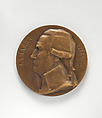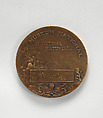Lamarck Medal with Case
François-Léon Sicard French
Not on view
Bashford Dean (1867–1928), the founding curator of the Arms and Armor Department, was also a highly regarded scientist. Our collection includes a wealth of information about Dean's work as a curator, scholar, and collector of arms and armor, but very little about his scientific career. Dean published several short articles about Jean-Baptiste Lamarck (1744–1829, a pioneering zoologist and botanist who developed an early version of the theory of evolution. According to a biographical essay by William K. Gregory, Dean was awarded the Lamarck Medal and made a Chevalier of the Legion of Honor in 1910 for "his efforts towards advancing the memorial to Lamarck."
A circular medallion on the obverse of which is a left-facing profile portrait bust of Jean-Baptiste de Lamarck in low relief, flanked along the curvature near the left edge by the word LAMARCK and near the right edge by his life dates, 1744–1829. Below the bottom right edge of the bust the artist's name appears as F. SICARD. On the reverse following the curvature near the top edge are the words MUSEUM NATIONAL and below this in two horizontal lines the words D'HISTOIRE/NATURELLE. Below this, in the center of the medallion, there is a rising sun in low relief, with plants and a snail to the left. Beneath the sun there is a plain rectangular cartouche engraved BASHFORD DEAN and in the center below this, near the bottom edge, there is an octopus in low relief. The disk-shaped case is covered in red leather and lined with green velvet. The top and bottom lids are hinged and the case is closed by a hook and eye fixture.
Due to rights restrictions, this image cannot be enlarged, viewed at full screen, or downloaded.
This artwork is meant to be viewed from right to left. Scroll left to view more.




